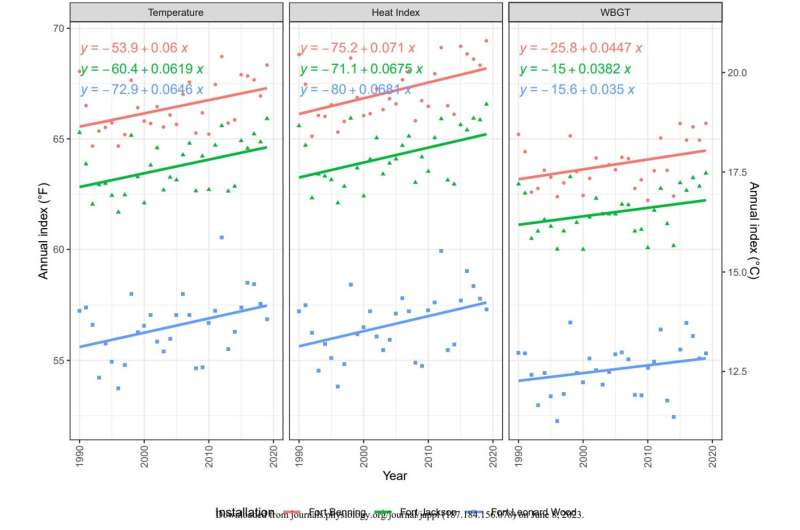This article has been reviewed according to Science X's editorial process and policies. Editors have highlighted the following attributes while ensuring the content's credibility:
fact-checked
peer-reviewed publication
trusted source
proofread
Climate change threatens military readiness, say experts

The growing frequency and intensity of heat waves around the globe pose "a substantial, persistent 'non-combat threat'" to military training and operations, according to experts in environmental, thermoregulatory and cardiovascular physiology. The scientists explain the threat and necessary steps for mitigating risk in an article published ahead of print in the Journal of Applied Physiology.
The risk of exertional heat illness (EHI) in military personnel is of particular concern. As the name implies, EHI occurs when heat exposure is combined with physical activity. EHI is a spectrum spanning from mild heat exhaustion to the serious condition of exertional heat stroke. Exertional heat stroke requires hospitalization and can result in long-term injury or death.
Even in absence of illness, however, researchers note that elevated temperatures can still impair performance as the body must divert resources away from muscle function toward temperature regulation.
Many aspects of military training and operations—such as wearing protective gear, carrying heavy packs and engaging in intense physical activity—all compound the risk of EHI. Further, researchers highlighted evidence that incidence of EHI increases during more important activities—such as milestone events or opportunities to earn awards—and among more motivated participants, as people are more likely to ignore early warning signs during these scenarios.
One current strategy to treat EHI already in use at Fort Moore (formerly Fort Benning), Georgia, is called "ice sheeting." A more portable option than the traditional cold-water bath, ice sheeting involves wrapping someone experiencing EHI in ice-soaked bed sheets, changing out the sheets every three minutes.
While some training situations could be modified by holding a march or run at a cooler time of day, reducing loads or modifying uniforms, others will require rigorous experimentation to balance different risks and mission needs. The researchers raised the possibility of "reversing sleep and wake hours" in hotter climates so service members could maintain physical fitness routines when temperatures are less dangerous. Such a shift would require thorough evaluation to avoid unintended consequences, such as disruptions to cognitive performance.
Other potential strategies to address heat illness risks worthy of further evaluation include:
- novel methods of rapid acclimatization,
- developing a scoring system for individual risk,
- expanding current human thermal models, and
- using real-time "non-invasive physiological monitoring."
"From a military mission perspective, it is also likely that troops with the best guidance and training approaches will be at the greatest advantage when it comes to successfully maneuvering in increasing environmental temperatures and heat load," the researchers wrote.
More information: Daniel S. Moran et al, Beating the Heat: Military Training and Operations in the Era of Global Warming, Journal of Applied Physiology (2023). DOI: 10.1152/japplphysiol.00229.2023




















